
Spur
Encyclopedia
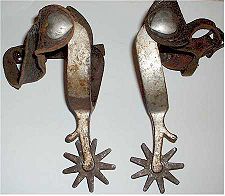
Riding boot
A riding boot is a boot made to be used for horse riding. The classic boot comes high enough up the leg to prevent the leathers of the saddle from pinching the leg of the rider, has a sturdy toe to protect the rider's foot when on the ground, and has a distinct heel to prevent the foot from sliding...
s for the purpose of directing a horse
Horse
The horse is one of two extant subspecies of Equus ferus, or the wild horse. It is a single-hooved mammal belonging to the taxonomic family Equidae. The horse has evolved over the past 45 to 55 million years from a small multi-toed creature into the large, single-toed animal of today...
to move forward or laterally while riding
Equestrianism
Equestrianism more often known as riding, horseback riding or horse riding refers to the skill of riding, driving, or vaulting with horses...
. It is usually used to refine the riding aids
Riding aids
Riding aids are the cues a rider gives to a horse to communicate what they want the animal to do. Riding aids are broken into the natural aids and the artificial aids.-Natural aids:...
(commands) and to back up the natural aids (the leg, seat, hands and voice). The spur is used in every equestrian discipline. There are rules in most equestrian organizations about spur design, use and penalties for using spurs in any manner that constitutes animal abuse.
Etymology
The very old word derives from Anglo-Saxon spura, spora, related to spornan, spurnan, to kick, spurn; cf. Medieval High German Sporn, modern German Sporn, Dutch spoor, Frisian spoar. The generalized sense of "anything that urges on, stimulus" is recorded in English from circa 1390.Design

- The yoke, branch, or heel band, which wraps around the heel of the boot.
- The shank or neck, which extends from the back of the heel band and is the area that usually touches the horse
- The rowel, seen on some spurs, a small revolving wheelWheelA wheel is a device that allows heavy objects to be moved easily through rotating on an axle through its center, facilitating movement or transportation while supporting a load, or performing labor in machines. Common examples found in transport applications. A wheel, together with an axle,...
or disk with radiating points at the end attached to the shank.
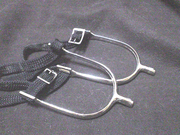
When used in military ranks, senior officers, and officers of all ranks in cavalry
Cavalry
Cavalry or horsemen were soldiers or warriors who fought mounted on horseback. Cavalry were historically the third oldest and the most mobile of the combat arms...
and other formerly mounted units of some armies, wear a form of spur in certain orders of dress which is known as the box spur, having no spur strap but a long metal prong opposite the neck, extending between the arms of the heel band, which is inserted into a specially fitted recess or "box" in the base of the boot heel. Due to the prong, such spurs can only be worn with appropriately equipped boots. This construction is shown in the illustrations of the swan neck and waterford spurs below.
Spurs seen in western riding
Western riding
Western riding is a style of horseback riding which evolved from the ranching and warfare traditions brought to the Americas by the Spanish Conquistadors, and both equipment and riding style evolved to meet the working needs of the cowboy in the American West...
may also have small curved-up hooks on the shank in front of the rowel, called "chap guards," that were originally used to prevent the rider's chaps
Chaps
Chaps are sturdy coverings for the legs consisting of leggings and a belt. They are buckled on over trousers with the chaps' integrated belt, but unlike trousers they have no seat and are not joined at the crotch. They are designed to provide protection for the legs and are usually made of leather...
from interfering with the rowels of the spur. Some cowboy
Cowboy
A cowboy is an animal herder who tends cattle on ranches in North America, traditionally on horseback, and often performs a multitude of other ranch-related tasks. The historic American cowboy of the late 19th century arose from the vaquero traditions of northern Mexico and became a figure of...
s also added small metal Pajados, also known as Jingo Bobs or Jingle Bobs, near the rowel, to create a jingling sound whenever the foot moved.
In the history of veterinary science, the word "rowel" described a small disk of leather
Leather
Leather is a durable and flexible material created via the tanning of putrescible animal rawhide and skin, primarily cattlehide. It can be produced through different manufacturing processes, ranging from cottage industry to heavy industry.-Forms:...
or other material that was used as a seton stitch.
History
The spur was used by the Celts during the La Tène period (which began in the 5th century BC), and is also mentioned by XenophonXenophon
Xenophon , son of Gryllus, of the deme Erchia of Athens, also known as Xenophon of Athens, was a Greek historian, soldier, mercenary, philosopher and a contemporary and admirer of Socrates...
(c. 430 - 354 BC.) Iron or bronze spurs were also used throughout the Roman Empire
Roman Empire
The Roman Empire was the post-Republican period of the ancient Roman civilization, characterised by an autocratic form of government and large territorial holdings in Europe and around the Mediterranean....
. The spur also existed in the medieval Arab world
Islamic Golden Age
During the Islamic Golden Age philosophers, scientists and engineers of the Islamic world contributed enormously to technology and culture, both by preserving earlier traditions and by adding their own inventions and innovations...
. Early spurs had a neck that ended in a point, called a prick, riveted to the heel band. Prick spurs had straight necks in the 11th century and bent ones in the 12th. The earliest form of the horseman's spur armed the heel with a single prick. In England, the rowel spur is shown upon the first seal of Henry III
Henry III of England
Henry III was the son and successor of John as King of England, reigning for 56 years from 1216 until his death. His contemporaries knew him as Henry of Winchester. He was the first child king in England since the reign of Æthelred the Unready...
and on monument
Monument
A monument is a type of structure either explicitly created to commemorate a person or important event or which has become important to a social group as a part of their remembrance of historic times or cultural heritage, or simply as an example of historic architecture...
s of the 13th century, but it does not come into general use until the 14th century. The earliest rowels probably did not revolve but were fixed.
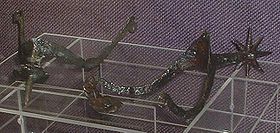
Knight
A knight was a member of a class of lower nobility in the High Middle Ages.By the Late Middle Ages, the rank had become associated with the ideals of chivalry, a code of conduct for the perfect courtly Christian warrior....
s were gilt
Gilding
The term gilding covers a number of decorative techniques for applying fine gold leaf or powder to solid surfaces such as wood, stone, or metal to give a thin coating of gold. A gilded object is described as "gilt"...
and those of squire
Squire
The English word squire is a shortened version of the word Esquire, from the Old French , itself derived from the Late Latin , in medieval or Old English a scutifer. The Classical Latin equivalent was , "arms bearer"...
s were silvered. "To win his spurs" meant to gain knighthood, as gilded spurs were reckoned the badge of knighthood. In the rare cases of ceremonious degradation, they were hacked from the knights heels by the cooks chopper. After the battle of the Golden Spurs
Battle of the Golden Spurs
The Battle of the Golden Spurs, known also as the Battle of Courtrai was fought on July 11, 1302, near Kortrijk in Flanders...
in 1302 where the French chivalry suffered a humbling defeat, the victors hung up bushels of knights' gilt spurs in the churches of Kortrijk
Kortrijk
Kortrijk ; , ; ) is a Belgian city and municipality located in the Flemish province West Flanders...
as trophies of what is still remembered by the Flemings as the Guldensporenslag (the battle of the golden spurs). For another reason the English named the French route beside Thérouanne
Thérouanne
Thérouanne is a commune in the Pas-de-Calais department in the Nord-Pas-de-Calais region of France.-Geography:Thérouanne is located 10 miles southwest of Saint-Omer, on the D157 and D341 road junction.-Population:-History:...
as the Battle of Spurs.
Prick spurs were the standard form until the 14th century, when the rowel began to become more common. The prick design never died out entirely, but instead became a thicker, shorter neck with a dulled end, such as the modern "Prince of Wales" design commonly seen in English riding
English riding
English riding is a term used to describe a form of horse riding that is seen throughout the world. There are many variations in English riding, but all feature a flat English saddle without the deep seat, high cantle or saddle horn seen on a Western saddle nor the knee pads seen on an Australian...
.
Though often decorated throughout history, in the 15th century, spurs became an art form in both decoration and design, with elaborate engraving, very long shanks and large rowels. Though sometimes it has been claimed that the design changes were used because of barding
Barding
Barding is armour for horses. During the late Middle Ages as armour protection for knights became more effective, their mounts became targets...
, the use of barding had fallen out of fashion by the time the most elaborate spur designs were created. More likely, the elaborate designs reflected the increased abundance of precious metals, particularly silver
Silver
Silver is a metallic chemical element with the chemical symbol Ag and atomic number 47. A soft, white, lustrous transition metal, it has the highest electrical conductivity of any element and the highest thermal conductivity of any metal...
, that followed the European exploration of the Americas
Americas
The Americas, or America , are lands in the Western hemisphere, also known as the New World. In English, the plural form the Americas is often used to refer to the landmasses of North America and South America with their associated islands and regions, while the singular form America is primarily...
that began in 1492. Spur designs in Spain and colonial Mexico
Mexico
The United Mexican States , commonly known as Mexico , is a federal constitutional republic in North America. It is bordered on the north by the United States; on the south and west by the Pacific Ocean; on the southeast by Guatemala, Belize, and the Caribbean Sea; and on the east by the Gulf of...
were particularly elaborate. For example, the spurs of the Spanish Conquistadors were sometimes called Espuela Grande, the "Grand Spur," and could have rowels as large as six inches around.
In northern Europe, the spur became less elaborate after the 16th century, particularly following the Stuart Restoration, but elaborate spur designs persisted, particularly in the Americas, descendants of which are still seen today, particularly in Mexico
Mexico
The United Mexican States , commonly known as Mexico , is a federal constitutional republic in North America. It is bordered on the north by the United States; on the south and west by the Pacific Ocean; on the southeast by Guatemala, Belize, and the Caribbean Sea; and on the east by the Gulf of...
and the western United States
United States
The United States of America is a federal constitutional republic comprising fifty states and a federal district...
, where the spur has become an integral part of the vaquero
Cowboy
A cowboy is an animal herder who tends cattle on ranches in North America, traditionally on horseback, and often performs a multitude of other ranch-related tasks. The historic American cowboy of the late 19th century arose from the vaquero traditions of northern Mexico and became a figure of...
and cowboy
Cowboy
A cowboy is an animal herder who tends cattle on ranches in North America, traditionally on horseback, and often performs a multitude of other ranch-related tasks. The historic American cowboy of the late 19th century arose from the vaquero traditions of northern Mexico and became a figure of...
traditions. The spur as an art form as well as a tool is still seen in western riding
Western riding
Western riding is a style of horseback riding which evolved from the ranching and warfare traditions brought to the Americas by the Spanish Conquistadors, and both equipment and riding style evolved to meet the working needs of the cowboy in the American West...
, where spurs with engraving and other artistic elements, often handmade and utilizing silver
Silver
Silver is a metallic chemical element with the chemical symbol Ag and atomic number 47. A soft, white, lustrous transition metal, it has the highest electrical conductivity of any element and the highest thermal conductivity of any metal...
or other precious metals are still worn.
Collecting of particularly beautiful antique spurs is a popular pastime for some individuals, particularly aficionados of western history and cowboy culture.
Spurs as modern honours
Just as a medieval knightKnight
A knight was a member of a class of lower nobility in the High Middle Ages.By the Late Middle Ages, the rank had become associated with the ideals of chivalry, a code of conduct for the perfect courtly Christian warrior....
was said to have "earned his spurs", the awarding of spurs has continued in the modern era as an honour bestowed upon individuals in organizations with military heritages, and among motorcycle riders. Members of the Papal Orders of Chivalry receive gilt spurs directly from the hands of the Pope
Pope
The Pope is the Bishop of Rome, a position that makes him the leader of the worldwide Catholic Church . In the Catholic Church, the Pope is regarded as the successor of Saint Peter, the Apostle...
; members of the British Order of the Garter
Order of the Garter
The Most Noble Order of the Garter, founded in 1348, is the highest order of chivalry, or knighthood, existing in England. The order is dedicated to the image and arms of St...
similarly receive gilt spurs from the Monarch. Inductees into the American Order of the Spur
Order of the Spur
The Order of the Spur is a Cavalry tradition within the United States Army. Soldiers serving with Cavalry units are inducted into the Order of the Spur after successfully completing a "Spur Ride" or for having served during combat as a member of a Cavalry unit...
receive gold-coloured (usually brass) spurs if they have earned their membership through combat, or silver-coloured (usually nickel) spurs if they have not seen combat, but complete a rite of passage
Rite of passage
A rite of passage is a ritual event that marks a person's progress from one status to another. It is a universal phenomenon which can show anthropologists what social hierarchies, values and beliefs are important in specific cultures....
.
Basic designs and wear
Spurs are worn with the tip of the neck pointed downward, sitting on the spur rest of the riding bootRiding boot
A riding boot is a boot made to be used for horse riding. The classic boot comes high enough up the leg to prevent the leathers of the saddle from pinching the leg of the rider, has a sturdy toe to protect the rider's foot when on the ground, and has a distinct heel to prevent the foot from sliding...
, if there is one, with the buckle of the spur strap worn on the outside of the foot.
Spur styles differ between disciplines. Spurs for western riding
Western riding
Western riding is a style of horseback riding which evolved from the ranching and warfare traditions brought to the Americas by the Spanish Conquistadors, and both equipment and riding style evolved to meet the working needs of the cowboy in the American West...
tend to be heavier, often decorated, and have rowels that rotate. The neck of western spurs is usually longer and the rowel wide in diameter, to accommodate the leg position of the Western-style rider, where the stirrup
Stirrup
A stirrup is a light frame or ring that holds the foot of a rider, attached to the saddle by a strap, often called a stirrup leather. Stirrups are usually paired and are used to aid in mounting and as a support while using a riding animal...
is adjusted long, and the heavy leather used for the saddle
Saddle
A saddle is a supportive structure for a rider or other load, fastened to an animal's back by a girth. The most common type is the equestrian saddle designed for a horse, but specialized saddles have been created for camels and other creatures...
's fenders and stirrups places the rider's leg a bit farther from the horse.
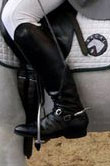
English riding
English riding is a term used to describe a form of horse riding that is seen throughout the world. There are many variations in English riding, but all feature a flat English saddle without the deep seat, high cantle or saddle horn seen on a Western saddle nor the knee pads seen on an Australian...
tend to use a spur that is very sleek, slim and conservative in design, with a shorter neck, as the saddle and leg position is closer to the horse. They usually have a rounded or blunt end. Rowels are not as popular as the plain blunt end, although there are types that include a rowel or smooth disk on the end. When used in sports requiring finesse, such as dressage
Dressage
Dressage is a competitive equestrian sport, defined by the International Equestrian Federation as "the highest expression of horse training." Competitions are held at all levels from amateur to the World Equestrian Games...
, the spur's purpose is not to speed up a horse, but to give accurate and precise aids
Riding aids
Riding aids are the cues a rider gives to a horse to communicate what they want the animal to do. Riding aids are broken into the natural aids and the artificial aids.-Natural aids:...
in lateral and complex movements, such as pirouettes, travers and renvers, and the airs above the ground. Dressage riders tend to ride in "Waterford" style spurs with a rounded knob at the end. Conversely, show hunter
Show hunter
The show hunter is a type of show horse that is judged on its movement, manners, and way of going, particularly while jumping fences. The horses are shown in hunt seat style tack, and are often of Warmblood or Thoroughbred type, though a hunter-style pony is also seen in youth classes...
and jumper
Show jumping
Show jumping, also known as "stadium jumping," "open jumping," or "jumpers," is a member of a family of English riding equestrian events that also includes dressage, eventing, hunters, and equitation. Jumping classes commonly are seen at horse shows throughout the world, including the Olympics...
riders may use a flatter end to encourage forward movement, such as the Prince of Wales design.
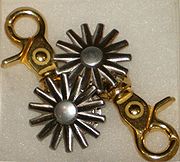
Motorcycle
A motorcycle is a single-track, two-wheeled motor vehicle. Motorcycles vary considerably depending on the task for which they are designed, such as long distance travel, navigating congested urban traffic, cruising, sport and racing, or off-road conditions.Motorcycles are one of the most...
spurs. They are characterized by rowels worn as foot jewelry, hung off of boots. They can be similar in appearance to spurs worn by equestrians. Their bright material attracts motor vehicle drivers to the presence of motorcyclists, especially to their feet where riders are most vulnerable when stopped in traffic. Their owners may further customize them by adding miniature strobing LED
LEd
LEd is a TeX/LaTeX editing software working under Microsoft Windows. It is a freeware product....
lights.
Equestrian riding technique
The spur is a refined tool, designed to allow the rider to transmit very subtle signals to the horse that are nearly invisible to any other observer. No matter the discipline, it is important that a rider has a correct position before using spurs, with a deep seat, legs lengthened to the extent allowed by the stirrupStirrup
A stirrup is a light frame or ring that holds the foot of a rider, attached to the saddle by a strap, often called a stirrup leather. Stirrups are usually paired and are used to aid in mounting and as a support while using a riding animal...
s, heels down, with knees and thighs rolled in so that the rider has a solid base of support. A swinging or unstable leg may inadvertently jab the horse with the spur as the rider sits, thus irritating, distracting, or frightening the animal, and chronic misuse may deaden the horse to the leg aids. Improper use may also provoke dangerous or undesirable behaviors such as bucking
Bucking
Bucking is a movement performed by a horse or bull in which the animal lowers his head and raises his hindquarters into the air, usually while kicking out with his hind legs. If powerful, it may unseat the rider enough so that he falls off....
or running away.
Spurs are rarely used in sports such as horse racing
Horse racing
Horse racing is an equestrian sport that has a long history. Archaeological records indicate that horse racing occurred in ancient Babylon, Syria, and Egypt. Both chariot and mounted horse racing were events in the ancient Greek Olympics by 648 BC...
, where the rider's leg is not significantly in contact with the horse.
Most spurs are activated by the rider flexing the heel slightly up and in. A roweled spur permits an additional type of action; a rider can roll the spur lightly against the side of the horse rather than being limited to simply pressing inward.
Rodeo spurring
The exception to the use of spurs in a subtle fashion is in the rodeoRodeo
Rodeo is a competitive sport which arose out of the working practices of cattle herding in Spain, Mexico, and later the United States, Canada, South America and Australia. It was based on the skills required of the working vaqueros and later, cowboys, in what today is the western United States,...
events of bull riding
Bull riding
Bull riding refers to rodeo sports that involve a rider getting on a large bull and attempting to stay mounted while the animal attempts to buck off the rider....
, saddle bronc and bareback riding
Saddle bronc and bareback riding
Bronc riding, either saddle bronc or bareback bronc competition, is a rodeo event that involves a rodeo participant riding on a horse , that attempts to throw or buck off the rider...
, where the rider is required to spur in an elaborate, stylized fashion, touching the horse or bull at every stride. This requirement is designed to resemble the behavior of old-time horse-breakers who would deliberately provoke a horse to buck. In modern times, riders are required to use spurs in a manner that is merely encouraging an animal that is already predisposed to buck; they are not to produce pain. Spur design and use is strictly defined by rodeo rules, spurs are dull and rowels must turn freely. In fact, the way spurs are to be used in bucking events generally makes it harder for the rider to stay on: in bareback bronc competition, the spurs must be above the point of the horse's shoulder at the first jump and remain forward at all times, deliberately creating a very awkward position for the rider that requires both strength and coordination to stay on the horse. In saddle bronc competition, the rider must make a full sweep with the spurs from shoulder to flank with each jump, requiring great concentration and any error in balance putting the rider in a position to be quickly unseated. Bull riders are allowed a position that is the closest to that of classic equestrianism, they are not required to spur the bull, but if they choose to spur, may do so with their legs down in a style that approaches a normal riding position.
Types of spurs




- Round end: end is a metal ball about the size of a small marble, making it one of the milder spurs
- Knob end: end of the spur is squared off but blunted at the edges
- Prince of Wales: has a flat end, making is slightly sharper. This is a popular spur.
- Rowelled spur: the end of the spur has a toothed wheel which spins. This is the most common western-style spur, although it is seen on some English-style spurs. Teeth are dulled at the points. A rowel with many small teeth is milder than one with only a few, larger teeth. Most rowels have at least eight teeth on each wheel. Other variations, more common in English riding, include:
- Disc: the end has a small rowel-like rolling disc without teeth, which allows the spur to roll on the horse's side when applied, decreasing chance of spur marks. Popular in dressage. Severity depends on thickness of disc.
- Roller spur: end of the neck has a plastic "roller," which moves as the horse's side is touched. This spur tends to reduce spur-rubs on sensitive horses. It is considered very mild.
- Swan-neck: the neck of the spur goes upward at an angle, before leveling off, looking similar to the neck of a swan. This is commonly seen in dressageDressageDressage is a competitive equestrian sport, defined by the International Equestrian Federation as "the highest expression of horse training." Competitions are held at all levels from amateur to the World Equestrian Games...
. - Waterford: the end of the neck has a large, round metal ball, making the spur softer and less likely to cause spur rubs.
- Le spur (English) or Barrel Racing Spur (Western): a spur with small "teeth" or ridges on the inside of the heel band, instead of a neck. For use, the rider does not have to turn in the heel. A quicker and more subtle design, but also more apt to be accidentally used when not intended.
- Half Mounted: The spur is decorated on one side only with silver, copper or bronze decals, logos or coverings.
- Full or Double Mounted: The spur is decorated on both sides (in and out) with precious metals, images and designs.

